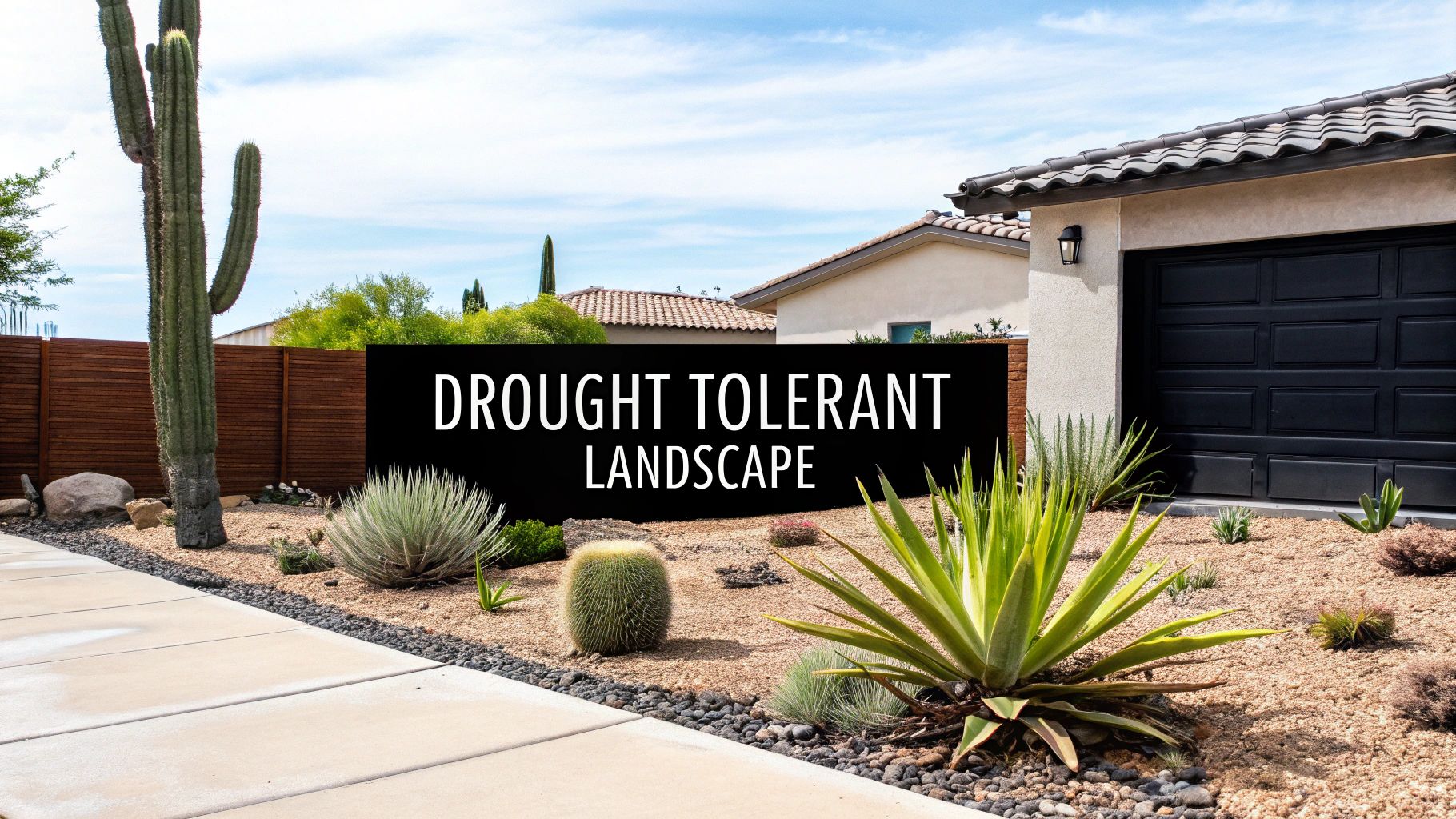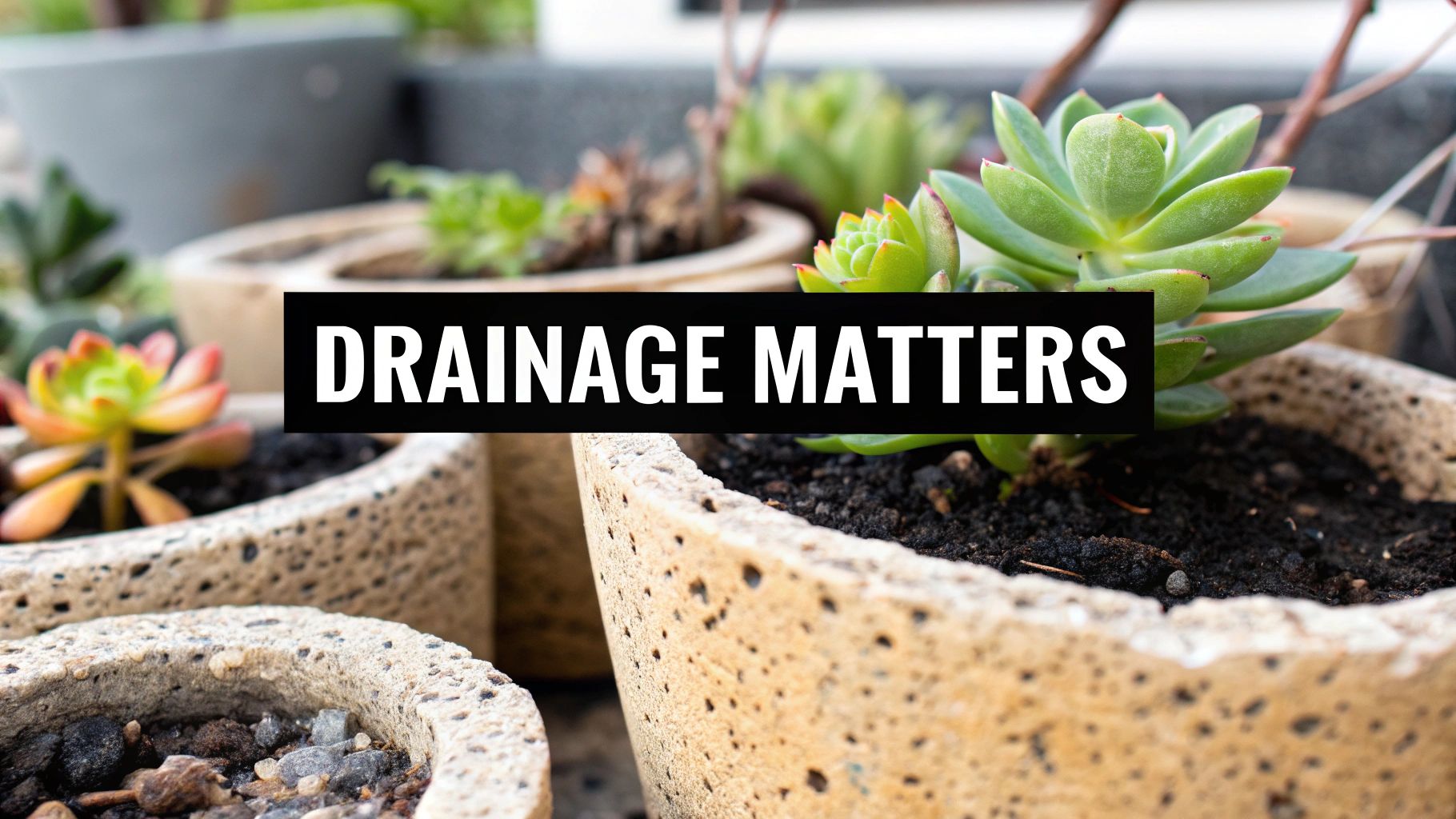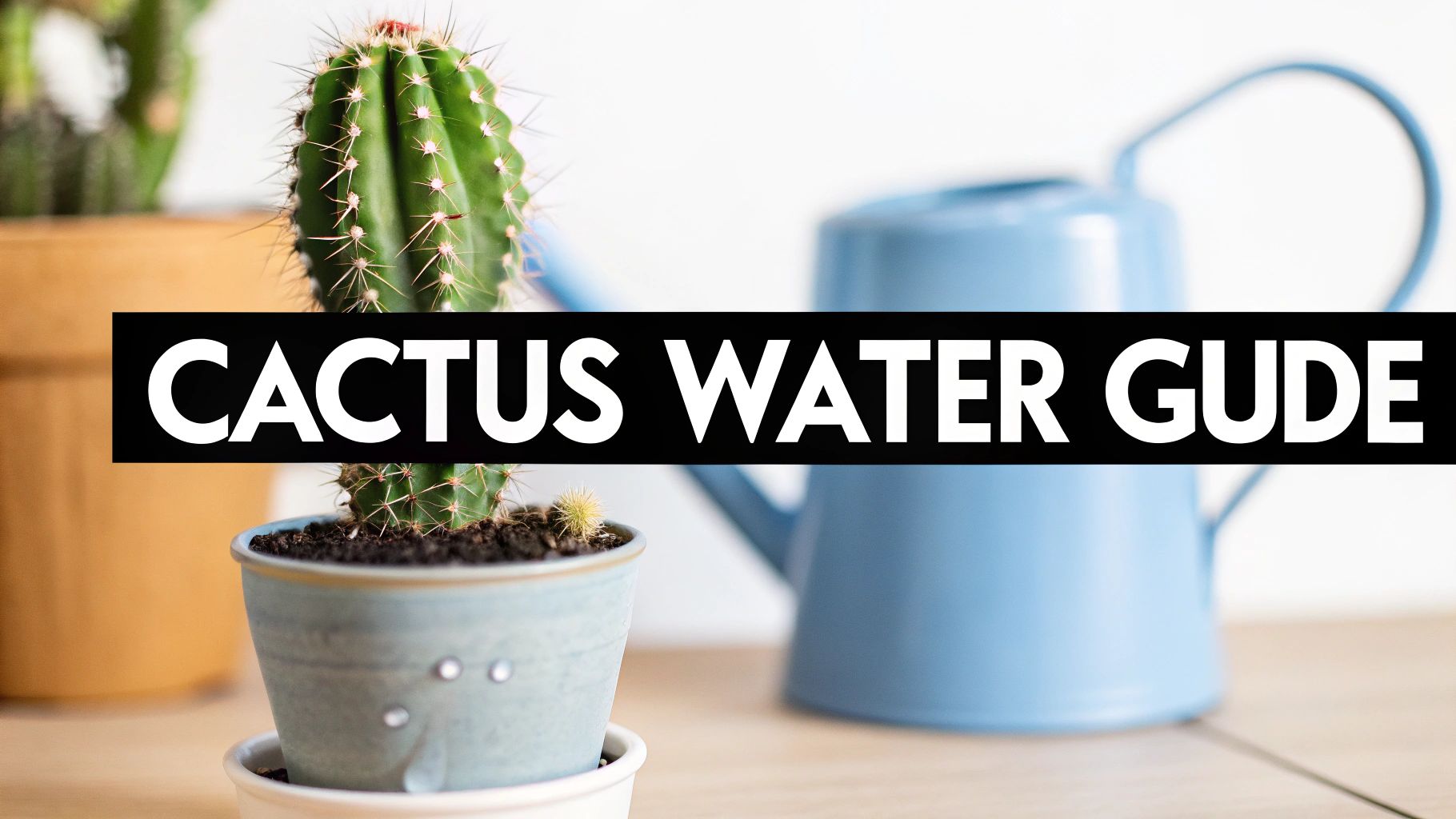A drought-tolerant landscape is all about creating a beautiful, resilient outdoor space using plants and techniques that sip, rather than gulp, water. It’s a philosophy centered on working with your local climate to build a thriving garden that's both sustainable and surprisingly low-maintenance. This isn't just about scattering some rocks and cacti around; it's a smart, thoughtful strategy for a stunning yard.
Why Water-Wise Landscaping Is a Smart Choice
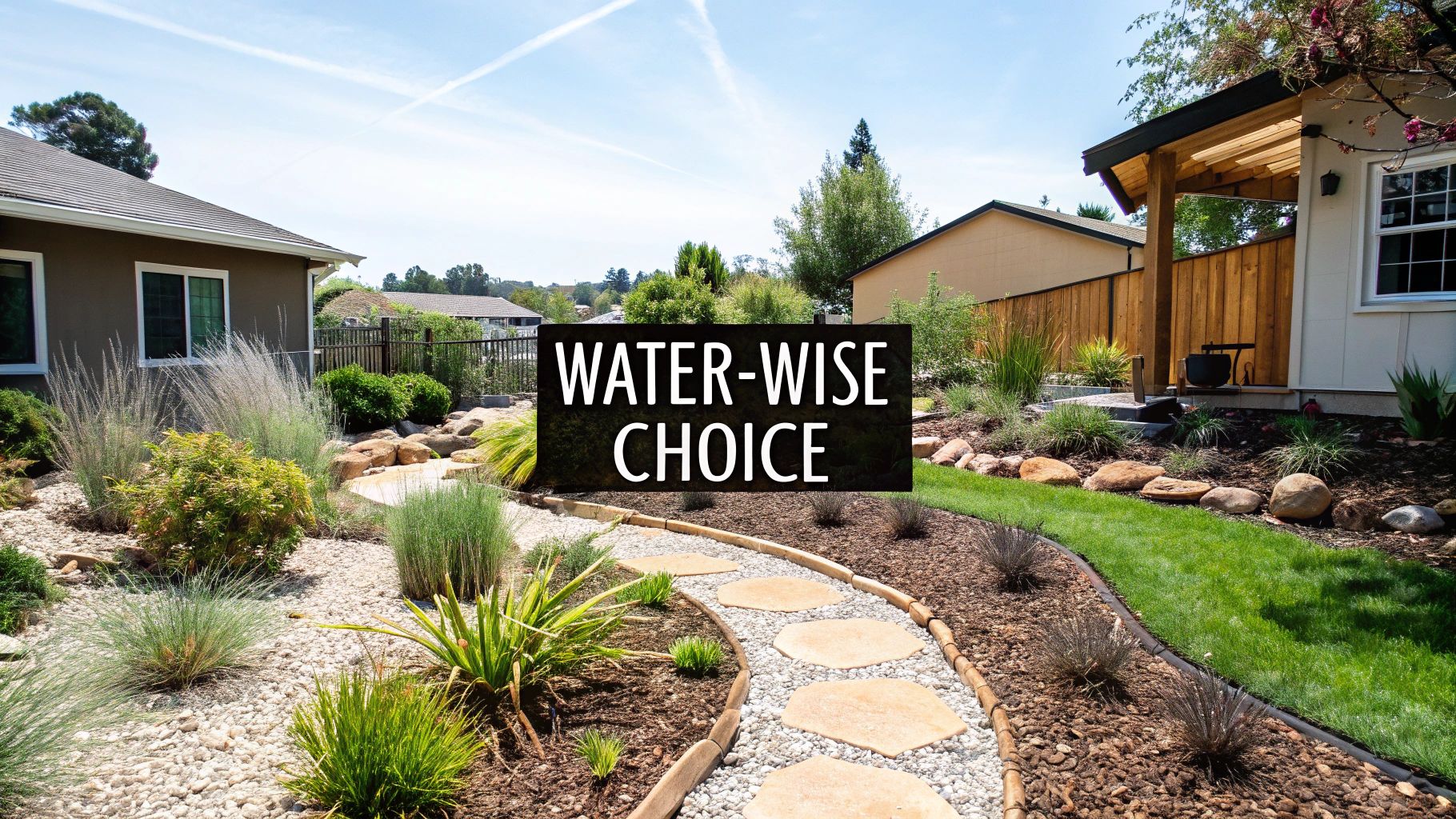
Making the switch to a water-wise yard is one of the most impactful decisions you can make, both for your wallet and the planet. This approach lets you move beyond thirsty, high-maintenance lawns and instead create a dynamic, self-sufficient ecosystem right outside your door. It’s a practical, forward-thinking response to growing water scarcity and the desire for a more sustainable lifestyle.
And it seems a lot of people agree. In the United States, demand for drought-tolerant landscapes shot up by about 30% in a single recent year, which shows a huge shift in what homeowners are looking for. This trend is especially noticeable in places like California and Colorado, where conserving water is top of mind. If you want to dive deeper, you can explore more about these trends in our guide to drought-tolerant plant choices for landscaping.
The Core Benefits of a Resilient Garden
The most obvious win here is the massive reduction in water use. When you choose plants that are naturally adapted to your climate and pair them with smart irrigation, you can slash your monthly utility bills. But it's about more than just saving money—it's about preserving a vital natural resource.
Beyond the savings, a drought-tolerant garden gives you your weekends back. Think about it: less time mowing, fertilizing, and watering means more time actually enjoying your outdoor space. These gardens are designed to be tough. They handle heat and dry spells with ease, so you can stop worrying every time the forecast looks a little dry.
The positive effects ripple out well beyond your own property line. A thoughtfully designed, water-wise garden also:
- Supports Local Ecosystems: Using native plants provides essential food and shelter for local birds, bees, and butterflies, which helps boost biodiversity in your neighborhood.
- Reduces Chemical Use: Hardy native plants rarely need pesticides or fertilizers. This means healthier soil and less chemical runoff polluting our waterways.
- Improves Curb Appeal: A landscape filled with varied textures, colors, and forms brings unique character and adds real value to your home.
This approach is really about creating a partnership between your garden and the local environment. You're building a landscape that doesn't just survive on life support—it actually thrives by working in harmony with nature's own cycles.
To truly appreciate the bigger picture, it helps to see how water-wise landscaping fits into broader eco-friendly construction principles. In this guide, we'll walk you through every stage of the journey—from analyzing your site and picking the perfect plants to installation and long-term care—so you can create your own beautiful and sustainable oasis.
Laying the Groundwork for a Resilient Garden
Every beautiful, low-water garden starts with a bit of detective work. Before you fall in love with the perfect agave or start digging, you have to get to know the land you're working with. This isn't just a suggestion; it's the secret to creating a landscape that truly thrives with less effort.
Think of your yard as a unique ecosystem. It has sunny spots, shady corners, different soil types, and gentle slopes. Understanding these little details is the most important part of the entire process. You have to work with your yard, not against it.
Getting to Know Your Yard's Microclimates
First things first, you need to become an observer. Grab a notepad and spend a couple of days just watching your property. Where does the sun land in the morning? Which spots get absolutely scorched by the afternoon heat? Where does the shadow of your house or a big tree create a cool, sheltered pocket?
What you're doing is creating a simple microclimate map. A microclimate is just a small area where the conditions are a little different from the rest of the yard. That spot next to a south-facing brick wall, for instance, is going to be a hot, dry heat trap—perfect for desert lovers. The north side of your house, however, might stay much cooler and hold more moisture, making it suitable for a completely different set of plants.
Mapping these out is easier than it sounds:
- Sketch your space: Draw a rough outline of your property, including the house, driveway, walkways, and any large trees or sheds.
- Follow the sun: Throughout a full day, use different shading to mark areas that get full sun (6+ hours), partial sun (4-6 hours), and full shade (less than 4 hours).
- Jot down notes: Don't forget to mark down other important features. Is one corner particularly windy? Is there a low spot where rainwater tends to puddle? What about the area under the eaves that never gets any rain at all?
This simple map is now your blueprint. It tells you exactly where specific plants will feel most at home, which is the cornerstone of a successful drought-tolerant landscape.
What’s Happening Beneath Your Feet?
Once you've mapped the sun, it’s time to get your hands dirty and figure out your soil. Soil is the engine of your garden; it determines how water and nutrients get to your plant's roots. For most of us, soil falls into one of three main buckets.
- Sandy Soil: Gritty and loose. Water runs right through it, taking valuable nutrients along for the ride.
- Clay Soil: Can be sticky when wet and hard as a rock when dry. It holds water tightly—sometimes too tightly—and can suffocate plant roots.
- Loam Soil: This is the gardener's dream. It's a balanced, crumbly mix that holds moisture but still lets excess water drain away.
Before you start designing, it's a great idea to perform a systematic check of your property's conditions. This checklist will guide you through the key elements to assess.
Site Assessment Checklist for Water-Wise Landscaping
| Assessment Area | Key Questions to Ask | Simple Test/Observation Method |
|---|---|---|
| Sun Exposure | Which areas get morning sun? Which get harsh afternoon sun? How many hours of direct sun does each spot receive? | Sketch a map of your yard and track the sun's path over a full day, shading areas based on sun duration (full, partial, shade). |
| Soil Texture | Is my soil sandy, clay-based, or loamy? Does it drain quickly or hold water? | Perform a "jar test": Fill a jar 1/3 with soil, add water, shake, and let it settle for 24 hours. Observe the distinct layers of sand, silt, and clay. |
| Soil Drainage | How quickly does water soak into the ground? Are there areas where water pools after rain? | Conduct a percolation test: Dig a 1-foot-deep hole, fill it with water, and let it drain. Refill it and time how long it takes for the water to disappear. |
| Wind Patterns | Are there windy corridors or protected pockets? | On a breezy day, walk your property and note where the wind is strongest. Look for natural windbreaks like fences or hedges. |
| Existing Slopes | Is the ground flat, or does it slope? Where does water run off during heavy rain? | Observe your yard during or right after a rainstorm to see how water moves across the landscape. |
Completing this assessment ensures you're basing your design on real-world data, not guesswork.
A quick and essential check is the percolation test. It tells you exactly how fast your soil drains. Just dig a hole about a foot deep and a foot wide, fill it with water, and let it drain completely. Then, fill it again and measure how much the water level drops in one hour. A drop of one to two inches is a good sign. If it's much less, you’ll know you need to work on improving your drainage.
This entire preliminary process—from mapping sun to testing soil—is captured perfectly in the infographic below.
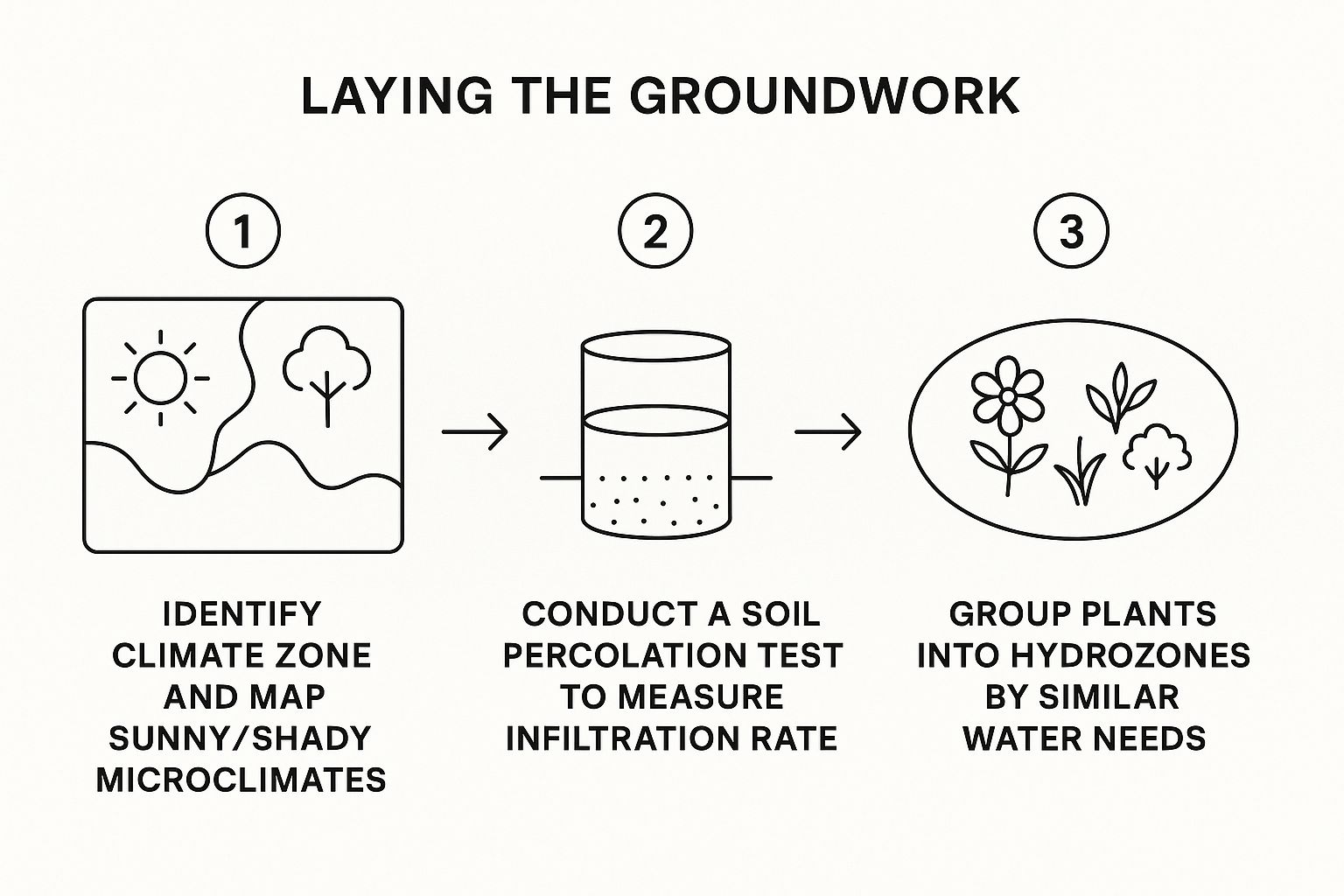
Taking these steps ensures you’re setting yourself up for success by making choices that align with your property's natural tendencies.
Smart Planting with Hydrozones
Now that you have all this great information, you can use one of the most effective strategies in water-wise landscaping: hydrozoning. It’s a fancy word for a simple concept: group plants together based on their needs. Plants that love water go together, and plants that prefer to stay dry go together.
This common-sense approach prevents you from drowning a cactus just to keep a thirsty fern happy a few feet away. It's all about efficiency. The severe California drought from 2011 to 2017 was a real-world lesson in this. Water restrictions forced everyone to abandon thirsty lawns, sparking a huge shift toward sustainable alternatives that can cut water use by 50-75%. You can read more about how recent landscape trends were shaped by these events.
Here’s how you might divide your yard into hydrozones:
- High-Water Zone: Keep this zone small and close to the house or patio where you can enjoy it. This is for the few plants that might need a bit more attention.
- Moderate-Water Zone: This is your middle ground. It's for plants that are fairly drought-tolerant once established but appreciate a drink during long dry spells.
- Low-Water Zone: This will likely be the largest part of your landscape. It's home to the toughest native and drought-tolerant plants that will thrive on rainfall alone after their first year.
By doing this thoughtful planning upfront, you’re creating a smart, resilient garden that works as a cohesive system, not just a random collection of plants.
Choosing Your Vibrant and Hardy Plant Palette
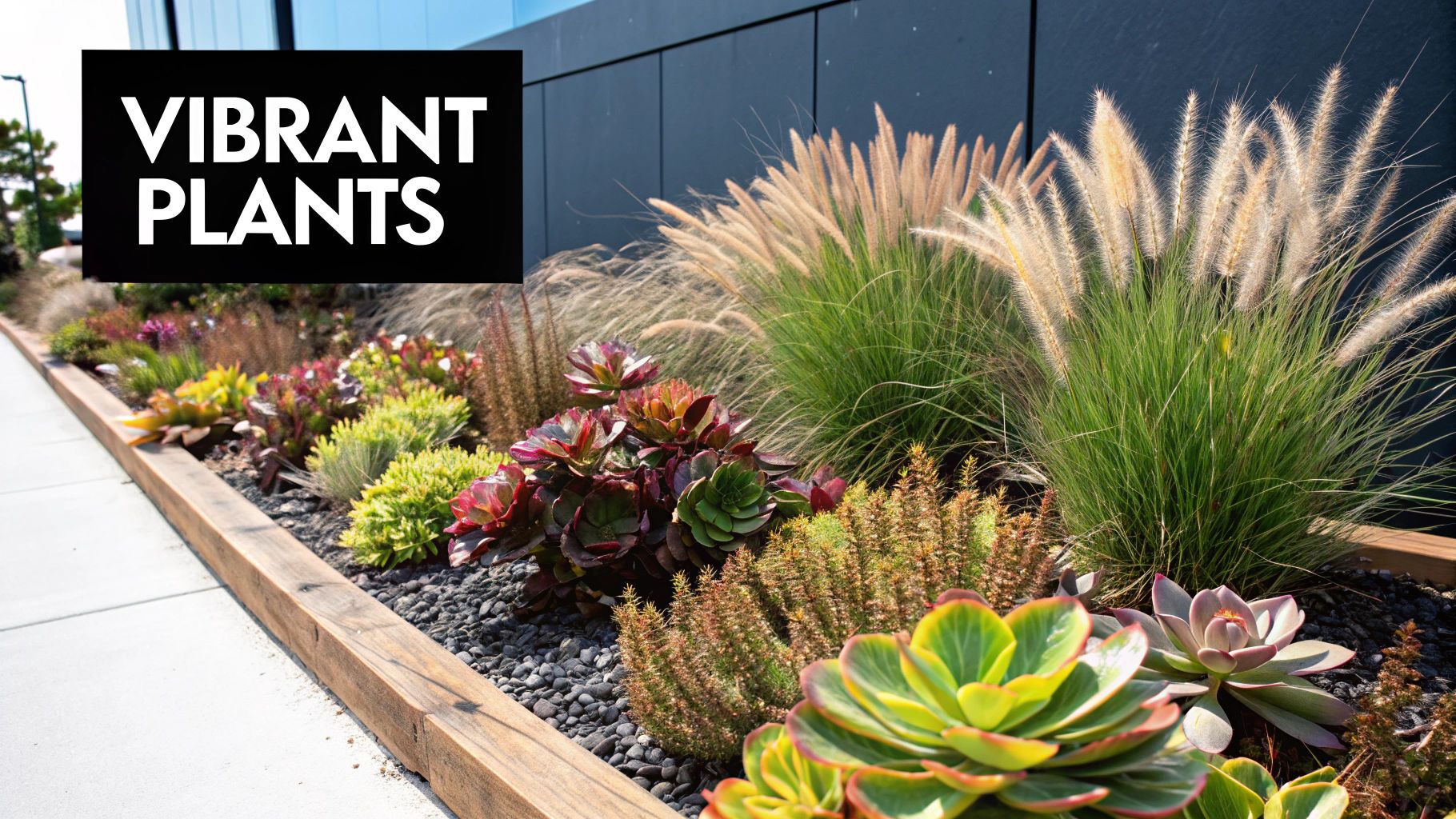
This is where your garden’s personality really begins to take shape. Let’s bust a common myth right now: drought-tolerant design is not a sterile world of rocks and a few lonely cacti. The reality is far more exciting. It’s an invitation to work with a rich tapestry of colors, textures, and forms that many traditional, thirsty gardens simply can't support.
The secret to a stunning, low-water garden is picking plants that are naturally built to thrive in your specific spot. We're not trying to force anything to survive here; we're choosing plants that feel right at home. All that information you gathered about your yard's sun, shade, and soil? That’s your roadmap to success.
Thinking Beyond Succulents
While striking succulents and architectural cacti are fantastic staples, they're only one part of the picture. A truly dynamic landscape needs balance—it pairs these bold, sculptural elements with softer, more fluid textures. This is where ornamental grasses and resilient perennials shine.
Ornamental grasses are the unsung heroes of the water-wise garden. They introduce movement and sound, catching the breeze to create a gentle rustle that brings a sense of calm. Their fine blades offer a beautiful contrast to the chunky leaves of agaves or aloes.
- Blue Fescue (Festuca glauca): This small, clumping grass forms neat little mounds of silvery-blue foliage, offering a cool color contrast that really pops.
- Muhly Grass (Muhlenbergia capillaris): Famous for its breathtaking, cloud-like pink plumes in the fall, this grass creates a soft, hazy effect you can't get anywhere else.
- Switchgrass (Panicum virgatum): As a taller native grass, it adds vertical structure and turns gorgeous shades of gold and red come autumn.
Once established, these grasses are incredibly tough and ask for little more than an annual trim. They're perfect for filling gaps, softening the hard edges of pathways, and ensuring your garden has visual interest long after the flowers have faded.
The Power of Native Plants
One of the most effective moves you can make is to lean heavily on plants native to your region. These are the species that have spent thousands of years adapting to your local climate, rainfall, and soil. By definition, they are the ultimate survivors.
There's a good reason this trend is growing. A recent study found that 17% of U.S. adults now prefer to buy native plants specifically because they need less water and fewer chemical inputs. This approach doesn't just save you time and money; it also creates a vital habitat for local pollinators, strengthening the entire ecosystem in your own backyard.
By choosing native plants, you're essentially hiring the perfect team for your garden—they already know the job, understand the local conditions, and don't need constant supervision. They just get to work creating a beautiful and resilient landscape.
Layering for Year-Round Appeal
A masterfully designed landscape looks good in every season, not just during peak bloom. The secret is layering plants with different heights, textures, and seasonal highlights. Think of it like composing music, with different instruments taking the lead at different times.
First, you need to establish the "bones" of the garden with evergreen structure—these are the plants that provide a consistent foundation all year.
- Structural Evergreens: Use larger succulents like a dramatic Agave or a bold Yucca as your main focal points. They provide architectural interest even in the dead of winter.
- Mid-Layer Perennials: Next, fill in the spaces with flowering perennials like Coneflower (Echinacea), Lavender, and Russian Sage (Perovskia). These add waves of color and are magnets for bees and butterflies.
- Low-Growing Groundcovers: Finish it off with a carpet of tough, spreading groundcovers such as Sedum or Thyme. They do a fantastic job of suppressing weeds, conserving soil moisture, and softening the entire look.
This layering technique ensures that as one plant finishes its show, another is just getting started. The silvery foliage of Russian Sage looks incredible against the deep green of a structural succulent, while the faded seed heads of ornamental grasses provide beautiful texture long after their summer color is gone.
Matching Plants to Your Garden Style
Ultimately, your plant palette should reflect your personal taste. A water-wise garden can be adapted to almost any aesthetic you can imagine, proving just how versatile these plants are. For inspiration, you can explore a curated list of the best drought-tolerant plants to get your ideas flowing.
Here are a few ways you can tailor your choices:
- Mediterranean Vibe: Think silvery foliage. Combine plants like Lavender and Olive trees with fragrant herbs like Rosemary and Thyme. Add pops of vibrant color with Bougainvillea or hardy geraniums.
- Modern Desert Look: Go for clean lines and bold shapes. Use groupings of columnar cacti, spherical Golden Barrel Cacti, and dramatic Agaves. A gravel mulch will complete the crisp, minimalist feel.
- Natural Cottage Garden: Want a softer, more romantic look? Plant drifts of pollinator-friendly perennials like Salvia, Yarrow (Achillea), and Penstemon. Weave in native grasses to create a relaxed, meadow-like atmosphere.
The most successful designs all come back to that one core philosophy: "right plant, right place." When you honor the conditions of your site and choose plants that will naturally thrive there, you create a garden that is not only beautiful and water-efficient but also resilient and truly full of life.
Integrating Hardscapes and Smart Irrigation
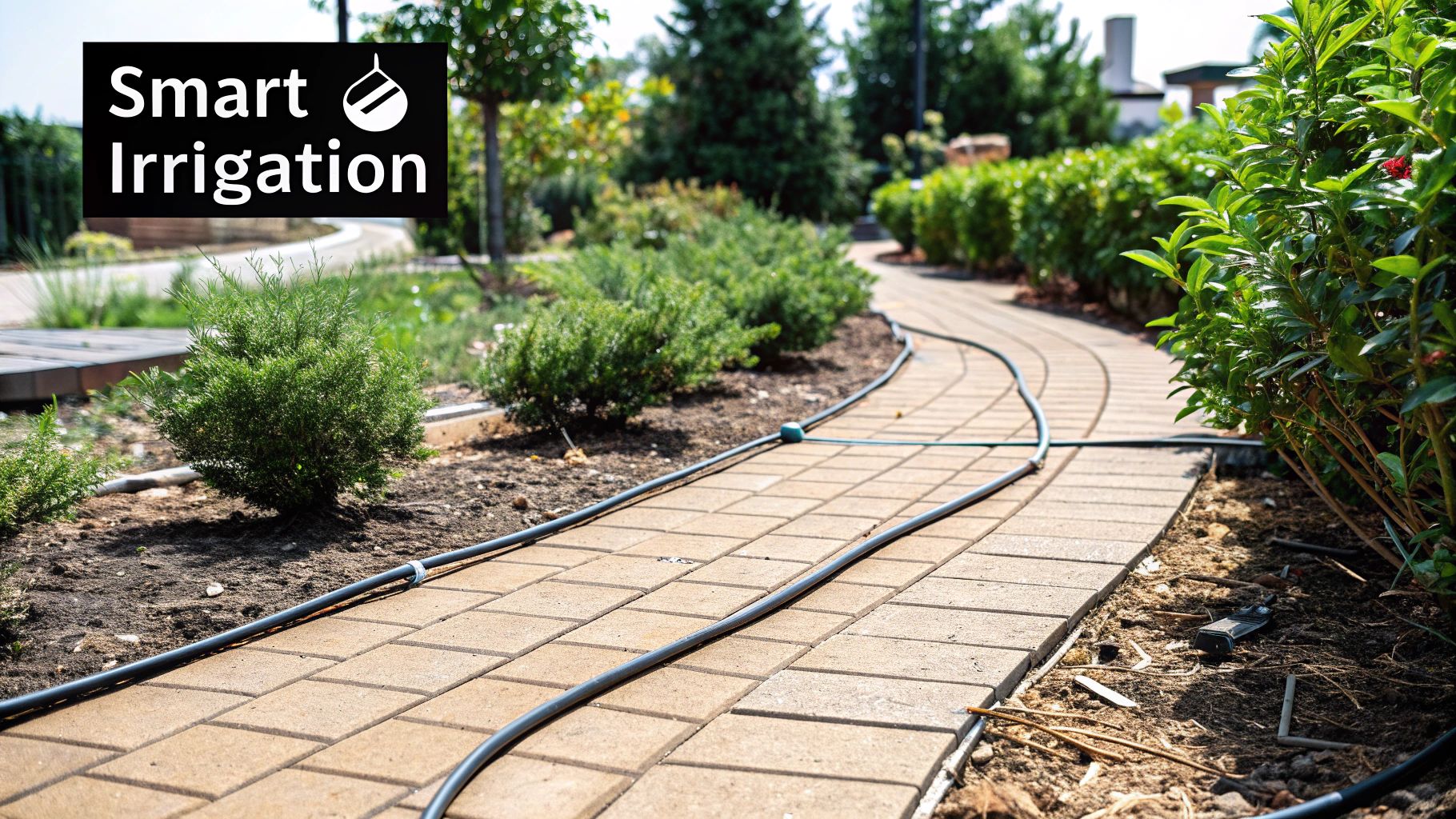
A truly successful drought-tolerant landscape is more than just a collection of plants. It’s a thoughtful balance of living elements with functional hardscapes and efficient watering systems. These non-plant features are the backbone of your garden, giving it structure, reducing thirsty lawn space, and making your yard a place you actually want to spend time in.
When you strategically swap out turf for a patio, a winding path, or a decorative gravel bed, you’re doing more than just saving water. You’re carving out purposeful outdoor living areas. This is the step where a garden transforms from a simple planting bed into a cohesive, beautiful, and remarkably low-maintenance space.
Choosing Permeable Hardscape Materials
The secret to great hardscaping in a water-wise garden is picking materials that work with nature, not against it. Traditional concrete and asphalt are a problem—they create solid surfaces that send precious rainwater rushing into storm drains. The solution is to think permeable.
Permeable materials let water soak through slowly, right where it falls. This simple choice helps recharge groundwater, cuts down on erosion, and makes sure every drop of rain gets put to work in your garden.
Here are a few of my go-to options:
- Decomposed Granite (DG): This is a fantastic material. It's a fine gravel that packs down to create a firm yet porous surface, perfect for natural-looking pathways or casual patios. It gives you a soft, earthy feel underfoot.
- Permeable Pavers: These aren't your grandpa's old concrete-slab pavers. They're designed with small gaps between them, which you fill with fine gravel. This clever system allows water to drain straight into the ground, making it a stellar choice for driveways and patios.
- Gravel and River Rock: Using gravel as a groundcover is a classic move in drought tolerant landscape design, and for good reason. It’s perfect for creating striking rock gardens or dry stream beds, and it serves as a permanent mulch alternative. If you're looking for more ideas, our guide to DIY rock garden ideas has plenty of inspiration.
These materials don't just reduce your lawn area; they introduce amazing textures and colors that perfectly complement the bold shapes of cacti and succulents.
Mulch: The Unsung Hero of Water Conservation
If there’s one secret weapon every water-wise gardener should have, it’s mulch. Spreading a thick layer of mulch across your garden beds is hands-down the most effective thing you can do to conserve soil moisture. It acts as a shield, protecting the soil from the blistering sun and drastically cutting down on evaporation.
But that’s not all it does. Mulch also keeps weeds from sprouting and stealing water from your plants. Plus, it helps regulate the soil temperature, keeping plant roots cooler in the summer and a bit warmer in the winter.
Choosing the right mulch for your landscape depends on your aesthetic and your plants' specific needs. Comparing the two main types can help you decide.
Mulch Type Comparison for Water Conservation
| Mulch Type | Pros | Cons | Best For |
|---|---|---|---|
| Organic (Bark, Wood Chips) | Enriches soil as it decomposes, improves soil structure, looks natural. | Needs to be replenished every few years, can harbor some pests. | Mixed garden beds where you want to build healthier soil over time. |
| Inorganic (Gravel, Pebbles) | Permanent (one-time application), excellent drainage, modern look. | Can absorb and radiate heat, doesn't improve soil fertility. | Cacti and succulent gardens that require fast drainage and a clean aesthetic. |
No matter which type you choose, a good rule of thumb is to apply a layer that's 2-4 inches deep. Just be careful not to pile it directly against the stems of your plants, as that can cause rot.
Demystifying Smart Irrigation Systems
The final piece of the puzzle is getting water to your plants efficiently—only when and where they need it. This is where modern irrigation technology is a total game-changer. Forget those old, wasteful sprinklers that soak the sidewalk more than the garden. Today's smart systems are all about precision.
Drip irrigation is the gold standard here. It uses a network of tubes with small emitters placed right at the base of each plant. Water is delivered slowly, directly to the root zone, which means no wasteful runoff or evaporation. It’s a targeted approach that makes every drop count.
Smart irrigation isn't just about saving water; it's about giving your plants exactly what they need to build deep, resilient root systems. By watering deeply but infrequently, you train them to become more drought-tolerant on their own.
These systems are booming in popularity, and it's easy to see why. The market for this technology is projected to hit $5.8 billion by 2033, and a typical system can save a household around 15,000 gallons of water each year.
For those who want to take water conservation to the next level, you can also integrate a rainwater harvesting system, which often relies on different types of vertical water storage tanks. By combining smart hardscapes, good mulching habits, and precise irrigation, you create a garden that's not just beautiful, but brilliantly self-sufficient.
Installation and Long-Term Garden Care
https://www.youtube.com/embed/UIwV8R-5xFw
You’ve got your design nailed down and your plants picked out. Now for the fun part: bringing it all to life. This is where your careful planning really pays off, and getting a few things right during the installation will set your garden up for years of low-effort beauty.
A truly successful drought-tolerant landscape design starts from the ground up—literally. Before any plants go in, you have to get the soil right. This is non-negotiable for succulents and native plants that absolutely hate having "wet feet" from poor drainage.
Prepping Your Soil for Success
Let's be honest, most garden soil isn't ready for drought-tolerant plants straight out of the box. Heavy clay soils hold on to too much water, inviting root rot. On the other end of the spectrum, sandy soils drain so fast the roots can't grab a drink. Your mission is to find that perfect balance.
The best way to do this is by amending the soil. If you're dealing with heavy clay, work in a generous amount of compost to break it up and improve aeration. For sandy soils, that same compost will help it hold onto precious moisture.
For desert plants that demand extremely sharp drainage, I always mix in some grit or small gravel right into the planting area. It’s a simple trick, but it makes a world of difference in helping the roots establish quickly and build resilience.
The Art of Planting Water-Wise Species
When you start planting, forget everything you know about traditional gardening. These plants have a different rulebook.
Dig your hole about twice as wide as the plant's root ball, but no deeper. This is key—it encourages the roots to spread out horizontally to find water, not down into soil that might stay too wet.
Before you place the plant, gently break up the bottom of the root ball to free any roots that have started circling in the nursery pot. Backfill the hole with your amended soil and tamp it down lightly.
One of the biggest mistakes people make is overwatering at this stage. Yes, they need some consistent water to get established, but they absolutely can't sit in soggy soil. Give them a good, deep watering right after planting, then let the soil dry out a bit before you water again. Getting this delicate balance right from the start is what sets them up for a long, healthy life.
Shifting to Smart, Long-Term Maintenance
Here's the real beauty of a drought-tolerant garden: once it's established, your role shifts from constant work to occasional, thoughtful care. You're no longer fighting nature; you're working with it. It's all about letting the garden’s natural resilience shine.
"Once established, a water-wise landscape doesn't just survive; it thrives on a 'less is more' approach. Your main goal becomes encouraging deep, strong roots that can find moisture on their own, making the garden nearly self-sufficient."
This combination of smart plant selection and efficient irrigation is a game-changer. Studies have shown that intelligent watering practices can cut outdoor water consumption by nearly 30%. To see how these methods fit into the bigger picture, you can check out the latest insights on sustainable design and other modern trends.
This new maintenance philosophy boils down to a few core practices:
- Deep, Infrequent Watering: Ditch the daily light sprinkle. Instead, water deeply but less often. This forces roots to grow deeper into the soil searching for moisture, making the plants incredibly tough during dry spells.
- Minimal Pruning: Most of these plants look best when left alone. For perennials, a quick trim after they bloom can sometimes encourage more flowers. For succulents, just pull off any dead leaves at the base. It’s that simple.
- Smart Weed Control: Mulch is your best friend here. A thick, 2-4 inch layer of organic mulch will smother most weeds before they ever see the light of day. This also ensures they aren't stealing water and nutrients from your plants.
By adopting this "smart care" approach, you’re creating a garden that not only saves a massive amount of water but also grows more beautiful and self-reliant every year. It’s proof that a stunning landscape doesn't have to be a thirsty one.
A Few Final Questions Before You Get Started
Even the best-laid plans can leave you with a couple of lingering questions. Shifting from a traditional lawn to a water-wise garden is a big change, so it's smart to tackle those last-minute "what ifs" before you break ground. Let's walk through some of the most common questions I hear from people making this transition.
Is This Going to Cost More Than Just Putting in a New Lawn?
I get this one a lot. The honest answer is: maybe, at first. The initial investment for a water-wise landscape can sometimes be higher than rolling out sod. You're often buying more mature plants, hardscape materials like gravel or stone, and maybe even setting up a new drip irrigation system.
But that upfront cost is only half the story. Think about what a traditional lawn costs you every single year—the water bill, the fertilizer, the pesticides, not to mention the mower maintenance. A drought-tolerant landscape starts paying you back right away with drastically lower water bills and almost zero ongoing costs. In just a few years, most people find the savings have more than covered what they spent to get started.
How Long Does It Take for Plants to Actually Be "Drought-Tolerant"?
This is a really important one to understand. Drought-tolerant doesn't mean you can just plant it and forget it, especially not at the beginning. Nearly every new plant, even the toughest succulents or native species, needs some time to get its roots established in its new home.
A good rule of thumb I always tell people is to plan on giving your new plants regular water for their first full growing season. That first year is critical for helping them develop a deep, robust root system that can find its own moisture later on.
After that initial establishment period, you can start tapering off the water significantly. You'll see their resilience build year after year, and soon enough, they'll be perfectly happy with whatever nature provides, except during the most extreme, prolonged droughts.
Will My Yard Still Attract Birds and Butterflies?
Oh, absolutely! In fact, a well-designed water-wise garden often becomes a far more vibrant habitat for local wildlife than a sterile green lawn ever could be. When you focus on native plants, you're essentially putting out a "welcome" sign for the birds, bees, and butterflies in your area.
Think of it this way:
- Native Flowers: Plants like Coneflower (Echinacea) and Salvia are packed with the nectar that hummingbirds, bees, and butterflies rely on.
- Seed Heads: If you leave the seed heads on your ornamental grasses and perennials through the fall and winter, you're providing a crucial food source for all sorts of birds.
- Layered Design: A mix of groundcovers, shrubs, and taller plants creates the kind of shelter and nesting spots that wildlife needs to feel safe and stick around.
A water-wise landscape isn't a sterile, empty space. It's a thriving little ecosystem buzzing with life, right in your own yard.
What’s the Easiest Way to Get Rid of My Old Lawn?
Tackling that existing lawn is always the first real step. From my experience, the most effective and earth-friendly way to do it is with sheet mulching. It lets you skip the chemical herbicides by simply smothering the grass.
It’s a pretty simple process:
- First, mow your lawn as short as it will go.
- Next, lay down a solid layer of cardboard over the entire area. Make sure to overlap the edges so no sunlight can peek through.
- Give the cardboard a good soaking with the hose to kickstart the decomposition process.
- Finally, cover it all with a thick, 4-6 inch layer of compost, and top that with another layer of mulch.
Over a few months, the grass and cardboard break down right in place, feeding the soil and leaving you with a beautiful, weed-free garden bed that’s ready for your new plants.
Ready to create a stunning, low-water garden of your own? At The Cactus Outlet, we have a huge selection of beautiful, hardy cacti and succulents perfect for any drought tolerant landscape design. Explore our collection and find the perfect plants for your project today!

